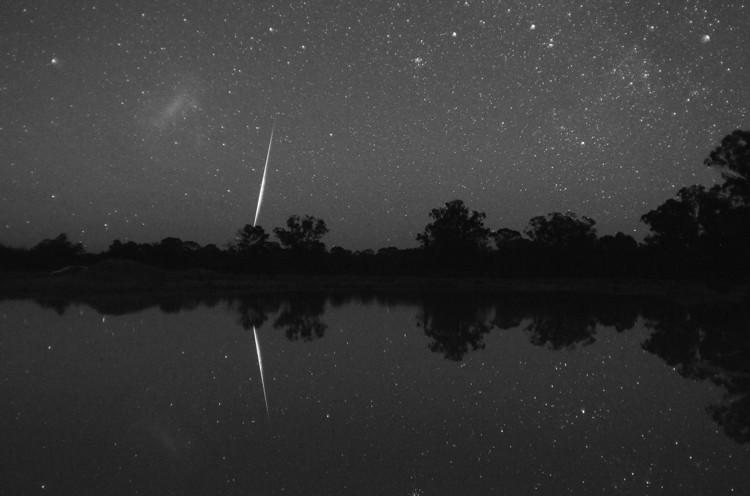This page describes an image Tra due cieli
Didascalia:
Menzione d'onore al concorso di astrofotografia IAU OAE 2022, categoria Immagini fisse di modelli celesti.
Scattata da Narrabri, in Australia, nell'aprile 2014, questa fotografia mostra una meteora accanto alla Grande Nube di Magellano e il loro riflesso sull'acqua.
Le Nubi di Magellano prendono il nome dall'esploratore portoghese Ferdinando Magellano, che all'inizio del XVI secolo realizzò le prime mappe della parte meridionale del Sud America, ma non sopravvisse al viaggio. I suoi compagni chiamarono le due nebulose con il suo nome e solo nel XX secolo la ricerca astronomica ha scoperto che si tratta in realtà di galassie nane che accompagnano la nostra.
Nel XVIII secolo, il matematico francese J-N. Lacaille, che visse per alcuni anni in Sudafrica per disegnare mappe del cielo e del territorio, inventò alcune nuove costellazioni. Misurò la posizione di alcune stelle deboli e le elencò nel suo catalogo stellare, ma non cercò di sovrapporre ai modelli stellari dei bei disegni di oggetti reali, per cui poté chiamarle come voleva. La sua base era la stazione commerciale che oggi è Città del Capo e, da questa baia, è visibile la Table Mountain. Lacaille apprese dai navigatori che usavano le nuvole intorno a questa montagna per prevedere se il vento avrebbe soffiato nella direzione giusta e permesso di veleggiare. Normalmente, in cima alla Table Mountain c'è un'enorme nuvola bianca, quindi Lacaille considerò la più grande delle due galassie nane non una "Nube di Magellano", ma la nube della Table Mountain. Di conseguenza, inventò la costellazione "Mensa", Table Mountain, nella piccola area di stelle deboli direttamente collegata a questa galassia nana.
Crediti:
Fabrizio Melandri/IAU OAE
Stato di traduzione della didascalia: Approvato da un revisore
traduttori della didascalia: Valentina La Parola
revisori della didascalia: Rodolfo Canestrari, Raffaella Ferretti
DOI: 10.5281/zenodo.7425545
Termini di glossario connessi:
Costellazione
, Grande Nube di Magellano (LMC)
, Piccola Nube di Magellano (SMC)
, Stella cadente
Categorie:
Galassie
, Astronomia ad occhio nudo
Licenza: Creative Commons Attribuzione 4.0 Internazionale (CC BY 4.0) Creative Commons Attribuzione 4.0 Internazionale (CC BY 4.0) icone
Didascalie in lingue diverse:
Didascalia: Lobende Erwähnung im IAU OAE Astrofoto-Wettbewerb 2022, Kategorie Weitwinkelaufnahmen von Himmelsmustern.
Dieses im April 2014 von Narrabri in Australien aus aufgenommene Foto zeigt eine Sternschnuppe neben der Großen Magellanschen Wolke und die Spiegelung davon im Wasser.
Die Magellanschen Wolken sind nach dem portugiesischen Entdecker Ferdinand Magellan benannt, der Anfang des 16. Jahrhunderts die ersten Karten des südlichen Teils von Südamerika anfertigte, seine Expeditionsreise aber nicht überlebte. Seine Schiffskameraden nannten die beiden Nebel nach ihm, und erst im 20. Jahrhundert entdeckte die astronomische Forschung, dass es sich in Wirklichkeit um Zwerggalaxien handelt, die unsere eigene Galaxis begleiten.
Im 18. Jahrhundert führte der französische Mathematiker J-N. Lacaille, der einige Jahre in Südafrika lebte, um Karten des Himmels und des Landes zu zeichnen, mehrere neue Sternbilder ein. Er maß die Positionen einiger schwacher Sterne und trug sie in seinen Sternkatalog ein, versuchte aber nicht, die Sternbilder mit schönen Zeichnungen von Objekten aus der realen Welt zu überlagern, so dass er sie benennen konnte, wie er wollte. Er lebte in einer Handelsstation, aus der später die heutige Stadt Kapstadt geworden ist, und von dieser Bucht aus ist der Tafelberg zu sehen. Lacaille erfuhr von den Seefahrern, dass sie die Wolken um diesen Berg herum nutzten, um vorherzusagen, ob der Wind aus der richtigen Richtung wehen und es möglich sein würde, in See zu stechen. Normalerweise befindet sich an der Spitze des Tafelbergs eine riesige weiße Wolke, so dass Lacaille die größere der beiden Zwerggalaxien nicht als "Magellansche Wolke" betrachtete, sondern als Wolke am Tafelberg. Deshalb erdachte er das Sternbild "Mensa", den Tafelberg, in dem kleinen Bereich schwacher Sterne, der direkt an diese Zwerggalaxie angrenzt.
Crediti: Fabrizio Melandri/IAU OAE
Termini di glossario connessi: Kleine Magellansche Wolke (KMW) , Large Magellanic Cloud (LMC) , Sternbild , Sternschnuppe Caption translation status: Non ancora approvato da un revisore
Caption translators: Carolin Liefke
Didascalia: Honourable mention in the 2022 IAU OAE Astrophotography Contest, category Still images of celestial patterns.
Taken from Narrabri, Australia, in April 2014, this photograph shows a meteor next to the Large Magellanic Cloud and the reflection of all this in the water.
The Magellanic Clouds are named after the Portuguese explorer Ferdinand Magellan, who made the first maps of the southern part of South America in the early 16th century but did not survive his expedition voyage. His shipmates called the two nebulae after him, and it was only in the 20th century that astronomy research discovered that they are in fact dwarf galaxies accompanying our own.
In the 18th century, the French mathematician J-N. Lacaille, who lived in South Africa for some years in order to draw maps of the sky and the land, invented some new constellations. He measured the positions of some faint stars and listed them in his star catalogue, but did not try to overlay beautiful drawings of real-world objects on the star patterns, so he could name them however he wanted. He was based in the trade station that is now the city of Cape Town and, from this bay, Table Mountain is visible. Lacaille learned from the navigators that they used the clouds around this mountain to predict whether or not the wind would blow in the correct direction and allow for sailing. Normally, there is a huge white cloud at the top of Table Mountain, so Lacaille considered the larger one of the two dwarf galaxies not a “Magellanic Cloud”, but the cloud at Table Mountain. Consequently, he invented the constellation “Mensa”, Table Mountain, in the small area of faint stars directly attached to this dwarf galaxy.
Crediti: Fabrizio Melandri/IAU OAE
Termini di glossario connessi: Constellation , Large Magellanic Cloud (LMC) , Shooting Star , Small Magellanic Cloud (SMC)









